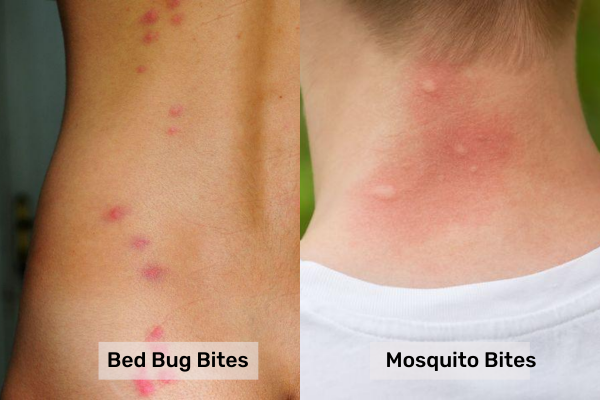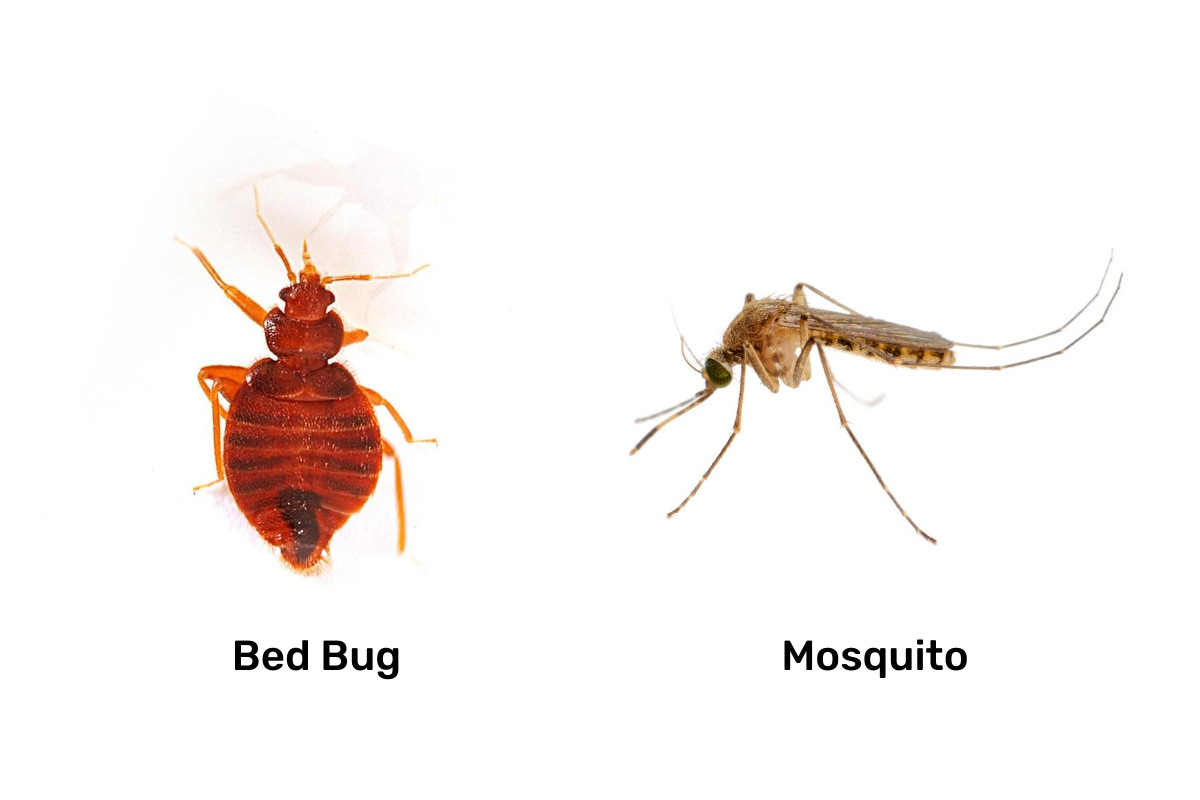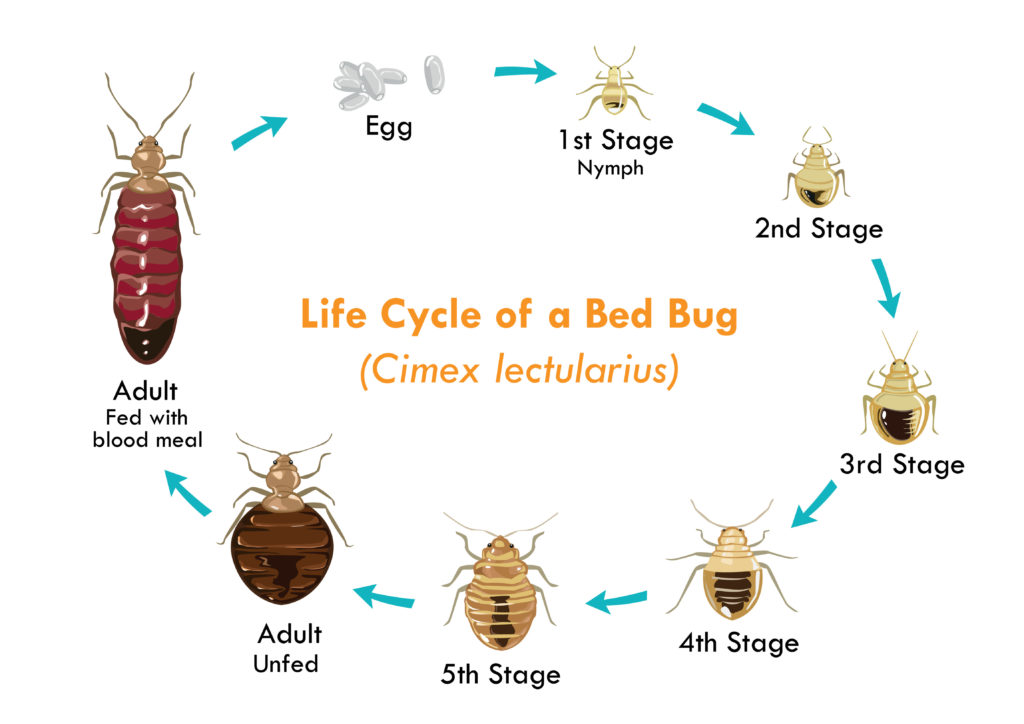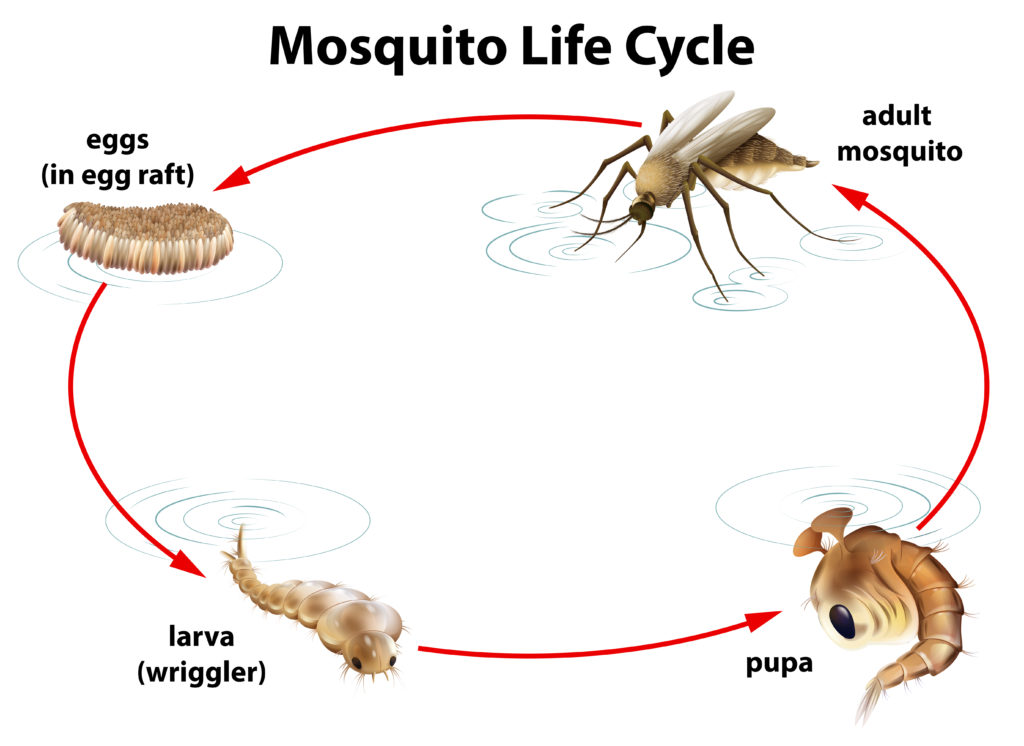Mosquito bites are often confused with bed bugs.
That’s no surprise since both blood sucking insects leave itchy, red bite marks on your skin.
Nonetheless, correctly identifying these two pests is vital to eliminate them.
In this article, we’ll go over all the differences between mosquitoes and bed bugs.
Let’s dive in.
Bed Bug Bites Vs. Mosquito Bites

Symptoms: A mosquito bite looks like a red, round, and puffy bump. They will become red and swollen soon after they bite you. In contrast, bedbug bites look like welts. The symptoms for bed bug bites can appear anywhere between an hour and two weeks after the bite occurs. Both bites are itchy and uncomfortable.
Pattern: Mosquito bites typically come with multiple bite marks in the same area. Bed bugs come in clusters and occur in a line or a zig-zag pattern.
Location: Mosquitoes will bite in any exposed skin. In contrast, bed bugs are more likely to target your legs, back, and torso. Bed bugs rarely bite on neck and faces, unless you’re wearing pants and long sleeves.
Development: While rare, bed bug bites can develop into severe reactions such as blisters, difficulty breathing, and nausea. Severe reactions to mosquito bites can cause significant swelling, hives, and fever.
Frequency: Mosquitoes will suck your blood until they are full. Once done, they will rest for two or three days. Bed bugs, on the other hand, will feed approximately once every three to ten days.
Bed Bug Bites Vs. Mosquito Bites: Treatment
Bed Bug Bite Treatment:
- Resist the urge to scratch.
- Wash affected area with soapy water this will help prevent an infection.
- Apply an anti-itch cream or ice on the bite to alleviate discomfort.
- Take an oral antihistamine to minimize itching.
- Use an over-the-counter pain reliever to reduce pain and swelling.
- For severe allergic reactions, seek professional care.
Mosquito Bite Treatment:
- Resist the Urge to Scratch. Excessive scratching can become infected.
- Wash affected area with soapy water. Washing your bite will help remove the germs on your skin and prevent infection.
- Apply an anti-itch cream or ice on the bite to alleviate discomfort.
- Take an oral antihistamine to minimize itching or apply an ice pack or cold compress.
- If your bites get worse over time, visit your doctor. Your doctor will be able to address any excess inflammation or infections with proper treatments.
Bed Bug Bites Vs. Mosquito Bites: Prevention
How to Stop Bed Bugs From Biting You?
Mattress and Couch Encasements
Mattress and Couch encasements create a barrier between you and the bed bugs living in your mattress. They are an inexpensive and quick solution to keep these bugs from biting you.
Pitfall traps
Pitfall traps capture bed bugs traveling between their harborage area and host.
They can be useful in preventing bugs from reaching and biting you.
Pitfall traps are typically made of a plastic dish and work based on the fact that bed bugs cannot climb slippery surfaces.
They are usually placed under bed legs and furniture to capture bed bugs crawling on the legs.
How to Stop Mosquitoes From Biting You?
Use A Mosquito Repellent
One of the most common ways to prevent mosquitoes from biting you is by applying chemical repellents that contain DEET, picaridin, or PMD.
Wear Light Colored Clothing
Mosquitoes are attracted to black, deep blue, and red. To keep yourself from being a target, stick to light colors.
Wear Loose, Long Sleeve Shirts, and Long Pants
Mosquitoes target exposed skin. To keep them away, cover as much as your skin as possible. You’ll also want to wear thicker fabrics when you can.
Looser clothing is also better than one that fits tightly on your body.

Bed Bugs Vs Mosquito: Appearance
- While adult bed bugs develop wing pads, they do not fly. Bed bugs do not grow functional wings, while mosquito has two. A mosquito can be distinguished from other insects by the scales in their wings.
- Both bed bugs and mosquitoes have six legs. But mosquito legs are much longer than bed bugs.
- Both mosquitoes and bed bugs have a straw-like tube called a proboscis for sucking blood.
- Bed bugs are around 4-5mm long. Mosquitoes are much larger at 2.5 to 10mm long.
- Mosquitoes are long and narrow, while bed bugs are oval and flat.
Bed Bugs Vs Mosquito: Distribution
In What Region Do Bed Bugs Live?
Bed bugs are found in all 50 states in the U.S.
Infestations are particularly common in large cities where houses are close together.
Bed bugs are also commonly found in apartments, public transportation, schools, nursing homes, and retail stores.
In What Region Do Mosquitoes Live?
Mosquitoes are found in all 50 states in the U.S.
Some of the worst states for mosquitoes are Georgia, Detroit, Florida, Virginia, Alabama, North Carolina, Texas and Oklahoma.
Bed Bugs Vs Mosquito: Habitat
Where Do Bed Bugs Live?
Bed bugs primarily live in bedrooms where food is readily available.
The most common areas to find bed bugs in your bedroom is on mattresses, box springs, headboards, nightstands, pillows.
On furniture bed bugs live in small seams, edges, folds in fabric, and small crevices that offer protection.
They are also commonly found in other regions of the home, including living rooms and home offices.
In severe infestations, they can live on walls, wood furniture, ceilings, and even baseboards.
Where Do Mosquitoes Live?
Mosquitoes need water for development.
Female mosquitoes lay their eggs on water. The eggs will eventually turn into a large and pupa, both of which are aquatic.
The ideal location for mosquitoes to thrive is non moving water.
That’s because mosquitoes need to breathe air through the surface of the water. They are very susceptible to wave action.
As such, you won’t find mosquitoes in open bodies of water like lakes or ponds.
Other than water, mosquitoes also need food to develop.
Mosquito larva eats microorganisms and floating organic matter. As such, you will see mosquitoes in places with plenty of vegetation.
You can find mosquitoes in saltwater and freshwater.
Mosquitoes are common in:
- Swamps
- Salt and freshwater marsh
- Ponds
- Drainage ditches
- Plants
- Tree holes
- Rain and floodwater pools
- Containers such as tires, tarps, pots, and buckets.
- Neglected hot tub and pool
- Water bottles and lids
- Bird baths
Mosquitoes prefer to live in shady areas, but can also develop in sunny locations.
Bed Bugs Vs. Mosquito: Diet
What Do Bed Bugs Eat?
Bed bugs drink blood to survive.
They commonly feed on humans but will resort to warm-blooded mammals such as dogs, cats, birds, and rodents if humans are not around.
Adult bed bugs can live for 12 to 14 months without a meal.
What Do Mosquitoes Eat?
Mosquito larva eats microorganisms and floating organic matter.
Adult male mosquito feed on nectar and sugars.
Female mosquitoes feed on blood as well as nectar and sugar.
Bed Bugs Vs. Mosquito: Flight
Do Bed Bugs Fly?
While adult bed bugs develop wing pads, they do not fly.
These wing pads do not develop into fully functional wings and have no practical use.
Do Mosquitoes Fly?
Mosquitoes are in the order of Diptera, meaning they develop two functional wings.
They fly to find food and sites to lay their eggs.
Mosquitoes’ flight distances vary greatly per species.
Most of them can fly anywhere between one to five miles.
Adult Salt flight mosquitoes can fly more than 20 miles.
In contrast, the Aedes mosquitoes can only fly a few hundred feet.
Bed Bugs Vs. Mosquito: Dangers
Are Bed Bugs Harmful?
Bed bugs do not carry any diseases and are relatively harmless compared to other pests such as mosquitoes and cockroaches.
Having a bed bug infestation can be disruptive to the well being of their human host.
Most people that have infestation suffer from anxiety and lack of sleep.
Bed bug bites can be extremely bothersome, especially for young children.
They can cause excessive scratching, leading to skin infections.
Bed bug bites also cause allergic reactions, and in severe cases, they may need medical attention.
Finally, their bites can transmit parasites, although it’s not common.
Are Mosquitoes Harmful?
Yes. Mosquitoes can transmit pathogens such as malaria, encephalitis, Zica, Dengue, and Chikungunya.
Bed Bugs Vs. Mosquito: Baby
What Do Baby Bed Bugs Look Like?
Bed bugs go through a partial metamorphosis, which means their babies look similar to adults.
Juvenile bed bugs, or nymphs, go into five stages before becoming a full adult.
When bed bugs first hatch, they are only about 1.5 mm long. They have white, oval, and flat bodies.
The nymphs also have two antennas and six legs.
As they mature, they gradually turn from white to dark brown.
Nymphs shed their skins to grow in a process called molting. Every time they molt, they become slightly darker and bigger.
Baby bed bugs need to feed on blood to grow. If they can find enough food, they can become full adults in about six weeks.
They can grow up to 4.5mm long before shedding their exoskeleton one last time.
What Do Baby Mosquito Look Like?
Juvenile mosquito is called larvae or wigglers.
These larvas have worm-like bodies that are light to dark brown.
Mosquito larvae can grow anywhere between 5-8 mm.
They live in water, but they have to come out on the surface to breathe.
Mosquito larvae use siphons for breathing. Siphons are the equivalent of snorkels.
Like snorkels, the siphon allows the larva to breathe while remaining underneath the water.
Mosquito larvae go into a few molts (instar) before entering pupation.
In the pupal stage, mosquitoes transforms into tumblers.
Their bodies are light brown with paddles. They also have a trumpet, which allows them to breathe on the water surface.
Pupation takes 2-3 days.
Bed Bugs Vs. Mosquito: Eggs
What Do Bed Bugs Eggs Look Like?
Bed bug eggs are white.
They are about 1 mm in length, similar to the size of two grains of salt.
They are sticky and are typically in clusters inside cracks and crevices.
Bed bug eggs take about two weeks to hatch into a white baby bed bug.
Once hatched, the juvenile bed bug will leave behind its eggshell, which generally looks like white debris.
What Do Mosquitoes Look Like?
Mosquitoes are aquatic. The female mosquitoes lay their eggs on the water.
The only exception to this is the mosquito specie Aedes, which lay their eggs in containers above the water line. These eggs will hatch when the container is flooded with water via high tides, rains or flooded stream bottoms.
Mosquito eggs are about .25 to .5mm depending on the species. These eggs are initially white, but will eventually turn black within a day.
Some mosquitos species lay their eggs singly and with floating devices to keep them on the surface.
Others lay their eggs in groups or three hundred or more. These eggs are glued together and float on the surface of the water as rafts.
Mosquito eggs hatch within one to three days, depending on the water temperature.
Bed Bugs Vs. Mosquito: Lifecycle
What Is the Bed Bug Lifecycle?
Bed bugs go through seven stages of development.
The first stage is egg, followed by five different nymph stages, and finally, the adult stage.
During the nymph stages, bed bugs progressively grow larger.
Nymphs must eat at least once to reach the next phase of development.
Bed bugs eggs take around five to six weeks for bud bugs to reach adulthood.

What Is the Mosquitoes Lifecycle?
Mosquitoes go through a complete metamorphosis. Their life-cycle consists of four stages: eggs, larva, pupa, and adult.
Mosquitoes are aquatic. The female mosquito needs to find a wet area to lay her eggs.
The eggs will eventually hatch into larvae. Mosquito larva lives in water and comes to the surface to breathe.
The larva will go through a few molts before it develops into a pupa. This process can take anywhere between a few days to a few weeks.
The pupa stage is the resting stage. The pupae live at the water surface to breathe, but they do not eat.
The pupal stage lasts anywhere from one to a few days, depending on the water temperature.
While inside the pupa, the mosquito develops wings and turns into an adult.
Mosquitoes’ total life cycle takes anywhere between four days to a month, depending on the conditions.
Adult female mosquitoes can for many weeks, while adult male mosquitoes die only a few days after they mate.

Bed Bugs Vs. Fleas: Causes
What Causes Bed Bugs?
Most often, bed bug hitchhike their way into your home from a location that already has bed bugs.
They can enter your home by attaching themselves to backpacks, luggage, clothes, grocery bags, etc.
In most cases, bed bugs don’t invade your homes from outdoors.
Bed bugs can also enter your home through used furniture, electronics, and clothing.
These bugs can hide inside used items for up to 12-14 months without eating.
There are some reports of bed bugs walking across power lines and outdoor walls, but this is rare.
What Causes Mosquito?
Mosquitoes thrive and develop in non-moving water. They only need approximately 1 tsp of water to develop
As such, one of the leading causes of mosquitoes in homes is the presence of small water-holding containers such as pots, buckets, tires, or jars.
Mosquitoes may also develop if you don’t have a proper drainage system. Small and temporary pools of water can be a perfect place for mosquitoes to lay their eggs.
Bed Bugs Vs. Mosquito: Elimination
How To Get Rid of Bed Bugs?
There are several different methods that you can use to eliminate bed bugs.
The one you choose will depend on the severity of your infestation and budget for treatment.
Common treatments include:
- Washing, Steaming and Vacuuming
- Heat Treatment
- Mattress Encasement
- Fumigation
- Chemical Insecticide
Vacuum Treatments
While you wouldn’t be able to target all bed bugs using vacuum treatments, this method is excellent at removing a large number of bed bugs, eggs, and shells skin quickly.
Removing these is vital in the treatment process because it gives you a clear picture of progress.
If you remove bed bug cast skin and eggs, you can do a follow-up and know if you’ve eliminated the infestation.
Heat Treatment
Extreme heat is fatal to bed bugs.
And heat treatments take advantage of this.
Heat treatments increase the heat in structures, rooms, and items to a temperature lethal to bed bugs and eggs.
Heat treatment for large areas requires specialized equipment designed and tested for bed bug control.
As such, treating entire structures or rooms need professional assistance.
Mattress Encasement
Mattress and box spring encasements can be a great way to control bed bugs.
Encasements create a barrier between you and the bed bugs living in your mattress.
They are great if you are looking for an inexpensive and quick solution for your bed bugs.
Encasements are also great to use if you do not want to dispose of heavily infested mattresses.
Fumigation
Fumigation treatments release fumigant gas into bed bug-infested areas to control bed bugs in all life stages.
The great thing about fumigation is its ability to penetrate areas that are difficult to access, such as tiny folds, seams, and intricate fabric.
That said, fumigation requires extensive preparation.
You’ll need to vacate all living things in your home until all traces of the fumigant have dissipated.
Fumigation also requires professional assistance, which can be costly.
Chemical Insecticide
When using insecticides, make sure to read and follow all label instructions.
Pay special attention to what type of furniture, surfaces, and materials is the insecticide safe to use
You’ll also want to pay attention to how long it takes before re-application and follow accordingly.
How to get rid of Mosquito?
Eliminate Standing Water
Mosquitoes thrive in shallow pools of stagnant water.
So, the first step to eliminating mosquitoes is to remove these.
To keep mosquitoes away, make sure you have a proper drainage system.
Also, ensure that your yard is designed to let the water flow away from your home when it rains. If that isn’t the case, contact a yard drainer professional to get your yard graded adequately.
Also, fix any uneven concrete that causes water to pool in one area during rainstorms.
Also, fix any plumbing issues that cause water to pool, including leaky faucets and other watering equipment.
Make sure to clean any clogged gutter to prevent water from pooling.
If you have any tree holes around your house that pools water, seal it with expandable water-resistant foam used for home insulation projects.
Remove any containers around your house that can cause water to pool.
Ensure you do not have plumbing issues and that your air conditioner drip line does not create water puddles.
If you have a birdbath in your home, drain it regularly to prevent mosquito development.
Space spray
To kill mosquitoes, professional pest control companies use either ground and aerial space spray.
Space sprays are liquid insecticides that are dispersed into the air instead of a surface.
While these sprays can be highly effective, their efficacy is dependent on a few factors.
Space sprays are most effective in low wind and high-temperature environments.
They are also useful while the droplets are in the air. As such, the mosquitoes need to be active or flying for the spray to be effective.
It’s also vital to have the correct droplet size for space sprays to stay airborne long enough to kill mosquitoes.
Mosquito Residual Adulticide
Residual adulticide is a treatment applied on surfaces where mosquitoes rest.
Unlike space sprays, you can apply residual adulticide at any time of day.
Another advantage of this method is that it provides long term control on resting mosquitoes.
That said, a significant disadvantage of this method is that it requires specialized training to be able to use this method effectively and safely.
